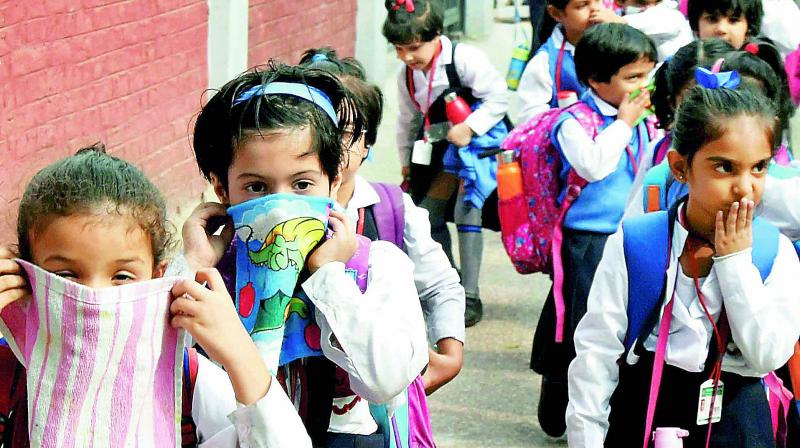How India Inc can help unmask our cities, make the air cleaner

It is that time of the year when air pollution in Delhi is a central preoccupation for all. An unprecedented health hazard is looming upon us, particularly impacting the health of our children and elderly ones.
A World Bank report highlights that environmental damage due to air pollution not only causes health hazards, but also costs three per cent of India’s GDP, with outdoor air pollution accounting for 1.7 per cent and indoor air pollution adding up to 1.3 per cent. It is important for all stakeholders to come together to find solutions to the major sources of air pollution in the national capital region. These sources may be primarily classified under transportation, industries, fuel, crop residue burning and domestic sources.
There is much that we can learn from Beijing, the Chinese capital, which took drastic measures to improve its air quality index. China rapidly scaled back the capacity for coal-fired power and steel, whose production threatened respiratory health. With stringent implementation of policies such as a nationwide air quality monitoring system, limiting the number of cars, enabling well-integrated public transport, and dramatically reducing the consumption of coal, China has been able to cut down on pollution levels radically. The country is also soliciting foreign investment in green energy technologies and has intensified inspections of major polluters around Beijing.
In India, Delhi and other cities are slowly but steadily moving towards tackling the air quality index. For the second year in a row, the Graded Response Action Plan is being implemented in Delhi to battle the increasingly thickening envelope of polluted air during the winter season. The Delhi Pollution Control Committee has already ordered industries in the city to switch to cleaner fuels, which include BS-VI diesel and petrol, natural gas, LPG and biogas.
Several other measures like banning import of polluting fuels such as pet coke, imposing restrictions on the use and sale of crackers, and short-term bans on construction and excavation work have also been instituted. But the journey of cleaning air requires more stringent steps, while engaging a wide range of stakeholders in the process.
Indian industry, over the years, has adopted various measures to control emissions caused by industry pollutants. Much more needs to be done to shift to cleaner fuels such as natural gas. In particular, there is a need to ensure ready supply of LPG and piped natural gas to industrial clusters in Delhi-NCR, introduce better taxation strategy for cleaner fuels and implement better distribution mechanisms for clean fuel in all towns/areas falling under NCR. The use of clean fuel in power and transportation must be promoted as well.
For curbing pollution due to construction activities, some construction companies are using water sprinklers, curtains, barriers and dust suppression units. This needs to become a universal construction practice. To combat the air pollution caused due to transportation, allowing retailing of bio-fuels, promoting electric mobility, decongesting traffic hotspots and retrofitting solutions are necessary action points.
One of the contributors of air pollution in Delhi-NCR, especially at this time of the year, is stubble burning in the adjoining states. The government announced a Rs 1,151-crore scheme over two years for subsidising farm tools that improve in situ straw management. The impact of this subsidy is visible from recent Nasa reports, which suggest that there is a decrease in the frequency of crop residue burning compared to last year. Still there are numerous red outlines in the paddy cultivating states showing active burning, adding to the problem of air pollution.
Industry can assist in this effort. In CII, we are working on a pilot field intervention in Punjab with farmers in partnership with the government to enable solutions to the problem of farm stubble burning. We are enhancing farmers’ knowledge and capacity on sustainable cropping systems, financially supporting them to procure and adopt new tools and technologies, and ensuring regular monitoring. The project has adopted 19 villages in Ludhiana and Patiala districts of Punjab, covering over 16,000 acres of farmland, and it is being noticed that most of the 3,000 farmers are now using alternative methods of managing straw over burning.
Companies can support farmers in the affected states, particularly Punjab and Haryana, through a two-pronged approach. First, companies can contribute through their CSR funds to support on-ground interventions in procuring the farm machinery for in situ management of straw, supporting the operational cost and sensitising farmers.
Second, going beyond financial support, corporates can create innovative business models to promote a sustainable value chain of straw. Value addition to straw can be an avenue of income for farmers. Companies can support farmer producer groups and village-level entrepreneurs to pilot small-scale ventures at the village level. This will help entrepreneurs to establish a marketing system and enable selling of these products at best prices.
While industry has a significant role in checking air pollution, civil society’s role is crucial in monitoring implementation and creating mass awareness for the prevention of air pollution and related health impacts. Lower use of firecrackers during Diwali indicates the potential of such civil society action.
The serious problem of air pollution cannot be addressed by any one group in isolation. The best solutions and inspiring acts can be implemented when all stakeholders join hands towards a common vision of change. We can unmask our cities only when the corporates, governments and farmers work together and act now.

